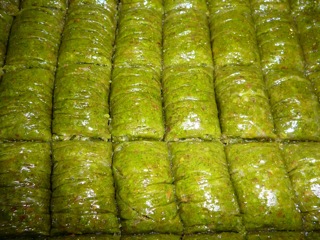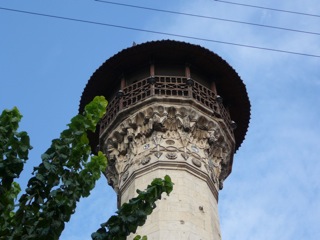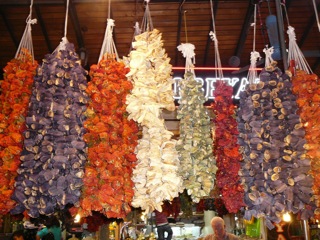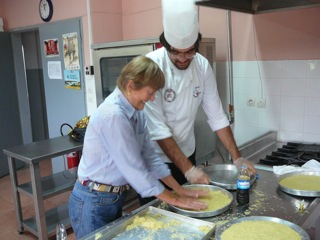Cooking & Feasting In Gaziantep, Turkey
Eating Well Is The Best Revenge
by Diana Farr Louis
 ATHENS, Greece—(Weekly Hubris)—11-8-2010—I’m sitting here nibbling on a bright green cylinder that’s about 3 inches long and 1 inch in diameter. It’s sweet but bearably so, and if I chew it just a bit and press the paste against the roof of my mouth, it starts to crumble into nutty heaven. This mysterious little stick is pistachio marzipan. Something I never knew existed until I visited Gaziantep last month. And now one taste acts like Proust’s immortal madeleine, bringing back all the memories of my week in Southeast Anatolia.
ATHENS, Greece—(Weekly Hubris)—11-8-2010—I’m sitting here nibbling on a bright green cylinder that’s about 3 inches long and 1 inch in diameter. It’s sweet but bearably so, and if I chew it just a bit and press the paste against the roof of my mouth, it starts to crumble into nutty heaven. This mysterious little stick is pistachio marzipan. Something I never knew existed until I visited Gaziantep last month. And now one taste acts like Proust’s immortal madeleine, bringing back all the memories of my week in Southeast Anatolia.

Through a truly miraculous concatenation of events I was invited to join a food workshop called Cuisine of Cultures held at the University of Gaziantep. It was one of many projects sponsored in the last decade by the Grundtvig Lifelong Education Programme throughout Europe and open to any EU citizen over the age of 18. I could apply as a Greek.
I first heard of Gaziantep in 1997 when I met Filiz Hosukoglu, a food historian with an engineering degree, at an Oldways conference in Crete (See “Remembering Dun Gifford,” 6/3/2010). Back then she planted a vision in my mind of her home town that was exotic yet welcoming, historically fascinating and gastronomically paradisiacal. Ever since, she’d been nurturing that image with enticing descriptions of food festivals, visits by other groups and, most recently, with a prize-winning downloadable guide to SE Turkey (http//seanatolianheritage.org), which she coordinated.
Originally I just wanted to see my friend again. Now I was beguiled by thoughts of amazing Roman mosaics, the Euphrates River, covered bazaars and mountains of pistachios. Of course, I had no idea what to expect from the food workshop—except possibly lots to eat—but I guessed I’d be the oldest and guaranteed to be the only American.
My flight from Istanbul landed in the semi-desert, a bewildering hodgepodge of half-built apartment towers of the Coop City Bronx model, pistachio groves and rock-strewn space. No sign of the dams and industry that in the past ten years have turned this small town two hours’ drive from Aleppo into a booming metropolis of 4 million people with a economic growth rate second only to China’s. And certainly no hint of exotic charm.

A closer look would reveal a city of a dozen parks, streamlined trams, Seljuk minarets and beautifully restored buildings—including a 15th-century hammam, a Byzantine church and the citadel, where the population resisted the French occupation in 1920 so heroically that Ataturk changed the town’s name from Antep to Gaziantep—Gazi means “veteran.”
That night Filiz met some of us in the old town and after a round of hugs led us into the Apple Bazaar, so called not because it once specialized in apples, but because it did not. Apples became a euphemism for the precious and rare, like the things on sale in these old stalls.

We gawped at pyramids of red pepper flakes in varying hues and strengths—another Antep specialty. Peered through curtains of hollowed-out dried eggplant, zucchini, bell peppers . . . which Turks like to stuff. And then brushed aside garlands of brightly colored leather shoes dangling next to displays of every imaginable sticky sweet, square loukoums (Turkish delight), walnut-grape molasses “sausages,” dried fruits and of course bins and bins of pistachios.
Next door to Filiz’s favorite spice emporium stood an unprepossessing empty shop with white tile walls and floors. There she introduced us to the owner, a sweet-faced man in his forties and a member of the famous Gulluoglu clan of baklava makers. Only one tray remained on the shelves, and in it just a few wedges of pistachio-filled golden phyllo. The first of many we would be served in this capital of Turkey’s baklava industry. Its 500 bakeries turn out tons of the stuff every day for distribution all over the country.
Indeed all week our hosts did their best to introduce us to the specialties of Gaziantep. They dined us—not wined, though—at the city’s best restaurants, so that we became very familiar with the local repertoire: lahmacun, Turkish “pizza,” the thinnest of doughs topped with minced veggies and lamb, which you then fill with parsley, hot green peppers and perhaps a dollop of chili-laced chopped salad, served with ayran, a cooling yogurt drink, to douse the fire. This would be followed by a soothing, mildish red lentil soup, a burek or two, and a plate of kebabs, skewered and/or minced lamb, and kibbe, mincemeat concealed in a hard crust of fine bulgur wheat. Ending with baklava and a glass of tea.
But we were not there just to feast on the best the area had to offer. We were expected to cook too. There were 15 of us EU participants, mostly in their 20’s, representing Estonia, Lithuania, Romania, Belgium, France and the UK, as well as the Turkish organizers and their team of students at the university’s tourism and cooking school.
We learned that the only thing Lithuanians don’t eat potatoes with is potatoes, that Romanians adore beans (the musical kind), and that Estonians are partial to meat loaf and deviled eggs. Our French delegate lived up to her country’s reputation by presenting us with a selection of runny cheeses and Burgundian wines and by whipping up a series of elaborate dishes right out of Escoffier.
One was a poule au pot simmered in a spicy bouillon and then browned under the grill. Delicious, it proved to be my downfall. For the next day was Greece’s turn at the stoves. My compatriot, a native Athenian, would make a delicious bianco from Corfu—“white” fish stew—and I had decided to demonstrate the art of avgolemono, how to thicken a soup with a mixture of eggs and lemon juice without having it turn into stracciatella—Roman-style scrambled egg soup.
My technique was perfect, but I blotted my copybook. I did not make my chicken broth from scratch but used the French bouillon with its aromas of star anise, juniper and rosemary. Not because I was lazy but because I hated the thought of all that broth going to waste. “No Greek would do a thing like that. Now everyone here is going to think avgolemono tastes of licorice,” my fellow Athenian hissed in horror.
She was right and I apologize. I think the others forgave me.
And now I finish off my pistachio memory stick and think of all the funny things. Like shopping for our cooking sprees in a vast wholesale megamarket where not one label was comprehensible and the package sizes were designed for orphanages. Like watching one stalwart Turkish cook knead fine bulgur for hours to make pea-sized “meat” balls and later appear with a wrist brace because even his strong arms were no match for that labor-intensive delicacy; dancing in the kitchen, meeting room and off our excursion boat onto a floating taverna by the shores of the Euphrates; and so much more.

Of course, the workshop was more about people than food. And as we cooked and ate together, explored the innards of Gaziantep and compared our reactions to the baklava factory, the mosaic museum, our scrubs in the hammam, the unfailingly cheerful Turks—both our hosts and literally everyone we met—we could not fail to bond. (Photo Capped: Me, Making Kataifi With Our Strong-Armed Turk)
We had just one reservation, perhaps there were a few too many pistachios.
On our second to last day, Filiz accompanied us to an old-fashioned coffee-house, complete with narghiles. There we tasted a new beverage—“coffee” made from wild pistachios. On top of all those green-stuffed sweets, we came to sympathize with the father of modern Turkey. As Filiz told us, after a visit that included a relentless parade of pistachio flavored envelopes, rolls, pies, angel hair and “coffee,” Ataturk finally pleaded, “Do you suppose it would be possible to have a coffee without pistachios?”
Now, three weeks later, I’m having withdrawal symptoms. Missing our food, our camaraderie, our tremendous fun. So to all the workshop members, “Tesekkur ederim.” Many, many thanks. Our organizers, Nur, Fatih and Burga, took our disparate ingredients and came up with a recipe for a truly unforgettable week.
One Comment
Fern Driscoll
Oh, what a time you had – I can almost taste the pistachios. It sounds like a joyous, delicious week – thank you for sharing!